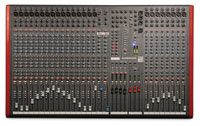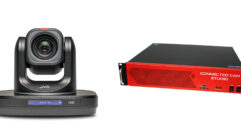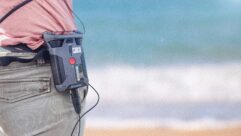

Allen & Heath ZED-428
Sep 3, 2009 12:00 PM,
By John McJunkin
An analog console gets advanced digital features.
Computer technology has fertilized the ground for the development of multi¬purpose mixing consoles that are not limited in terms of application to live sound or recording. Surprisingly, this versatility is not just relegated to the ranks of digital mixers. There are indeed analog consoles that benefit from computer connectivity. Among these is Allen & Heath’s (A&H) ZED-428, a larger and more sophisticated big brother to the A&H ZED-14, which I reviewed in May 2008. Among the features that are upgraded in the ZED-428 is a 4-band EQ with two sweepable mid bands—borrowed directly from A&H’s popular GL2400 console. The ZED-14 has a 3-band EQ section. There are two major features that are shared by both mixers: the DuoPre mic/line preamp and the capacity to route signals both to and from a computer via USB. The latter is a powerful feature that expands the usefulness of the console and makes it very worthy of consideration.
The ZED-428 is 22in. deep, 37in. wide, and 5in. tall. Measuring in at just more than 3ft. wide, this console can be said to have a small footprint, particularly considering its 28 inputs and four buses. Each of the console’s 24 mono input channels feature (from top to bottom along the channel strip) a 1/4in. balanced direct output, an XLR mic input, a 48V phantom power switch, a 1/4in. balanced line input, and a 1/4in. insert. I like the fact that there are analog direct outputs for multitrack recording, making the console vastly more useful. Continuing down the channel strip, there is a gain knob, a 100Hz HPF switch, and the 4-band EQ. The high shelf corner is at 12kHz, and the low shelf corner is at 80Hz. The HM and LM bands boost or cut 15dB and are sweepable from 500Hz to 15kHz and 35Hz to 1kHz, respectively. South of the EQ section are the console’s six auxiliary sends. Auxiliaries 1 and 2 are permanently prefader, 5 and 6 are permanently postfader, and 3 and 4 are switchable (as a pair). Continuing on below the auxiliaries are the principal controls: a pan pot, a mute switch, a prefader listen (PFL) switch, signal and peak LED, a 100mm fader, and switches that determine to which buses the channel’s signal are routed—L-R, M (mono), 1-2, 3-4, or any combination of these.
The console also features two stereo inputs, bringing a total of four more signals into the mix. These inputs are virtually identical to the mono inputs, but they lack direct outputs, phantom power, inserts, and sweepable mids (HM is fixed at 2.5kHz and LM at 250Hz). Both RCA and 1/4in. balanced inputs are available for the stereo channels. Recessed switches determine whether the stereo inputs are routed through the stereo channels or directly to L-R bus. The console also features two matrix outputs, which deliver a mix of the console’s four groups, left and right buses, and the mono bus. Each matrix mix has a master level knob and an after-fader listen (AFL) switch. There are also auxiliary master knobs for all six auxiliaries, along with AFL switches for each. The console’s four groups each feature a fader, an AFL switch, a mute switch, a four-segment LED meter, a pan knob, and routing switches to determine whether groups are routed to the L-R or M bus or both. The master section features faders for L, R, and M, along with mute switches and four-segment LED meters for each. A headphone source switch and level knob are also found in the master section. A metering/talkback section features the console’s headphone output, XLR talkback mic input (with level control), routing switches, a 12-segment LED stereo meter, and a PFL/AFL active LED as well. In terms of outputs, there are balanced outputs for the six auxiliaries, the four groups (with inserts), the three primary outputs (also with inserts), and the two matrix outputs. There are also RCA 2-track inputs and outputs.
The USB section of the console features switches that determine which signals are sent via USB—giving the options of the L-R bus (both pre- and postfader), auxiliaries 1-2 or 5-6, or matrix 1-2. There is a switch that determines whether stereo input 3 receives the input of its own RCA stereo pair or the signal from USB. There is also a switch that determines whether playback is fed by the console’s 2-track RCA input pair or USB. A switch determines whether playback is fed to the L-R bus, and a knob determines level of playback. There is also a PFL button for playback.
Allen & Heath ZED-428
Sep 3, 2009 12:00 PM,
By John McJunkin
An analog console gets advanced digital features.
Allen & Heath’s DuoPre preamps come from A&H’s PA series, and they exhibit a clever two-stage design that results in dead-quiet operation with great fidelity. Line-level inputs are plugged directly into the second stage of the preamp, which I found to really reduce noise when using the line input. As stated before, the console’s 4-band EQs are lifted directly from A&H’s GL2400 console. I have always been a fan of Allen & Heath’s EQ; in my estimation, it’s a principal feature that would steer one toward the brand. I’m happy with the complement of six auxiliaries—considering the likely applications for a console of this size, six should typically be plenty. Far and away, the most forward-thinking feature of the console is the USB implementation. It really is nice to be able to easily move signals to and from a computer without even thinking about it. An obvious use for this is to record the stereo mix from the console directly with a digital audio workstation, and A&H bundles Cakewalk’s Sonar LE for this purpose. Another obvious use for the USB interface is for playback from a computer. A not-so-obvious application for the USB interface is as a send-return effects loop. I have more than a few effects plug-ins on my computers that I love, and the ZED-428 presents a highly simplified way to implement them into live mixes or the recording process. On my wish list for future revisions is the capacity to simultaneously send all four of the console’s groups via USB to the computer. This requires more interface horsepower, and it would increase the price of the console, but it would be a powerful feature in my opinion.
Related Links

Allen & Heath ZED-14 review from
Electronic Musician

Allen & Heath ZED-14 review from
SVC

As is, the USB implementation is powerful and useful, and the signal-flow layout of this console is robust and practical as well. The preamps are dead-quiet and sound great, as does the EQ in this console. For any user who has the need for a console that exhibits more sophistication and quality than other consoles in the same price range, this is one I can strongly recommend.
John McJunkin is the principal of Avalon Podcasting in Chandler, Ariz. He has consulted in the development of studios and installations, and he provides high-quality podcast-production services.
PRODUCT SUMMARY
- Company: Allen & Heath
www.allen-heath.com - Product: ZED-428
- Pros: 4-band EQs from the GL2400 console; clever signal-routing possibilities; USB interface.
- Cons: Simultaneous routing of all four groups via USB to computer would be nice.
- Applications: Live sound, recording.
- Price: $1,799
SPECIFICATIONS
- Analog headroom: 21dB (from nominal—0Vu)
- USB I/O headroom: 14dB (from nominal—0Vu)
- Frequency response: Mic in to mix L/R out, +0.5/-1dB 20Hz-20kHz (30dB gain)Line in to mix L/R out, +0.5/-1dB 10Hz-30kHz (30dB gain)Stereo in to mix L/R out, +0.5/-1dB 10Hz-30kHz (30dB gain)
- Total harmonic distortion: Mic in to mix L/R out 0.004% (0dB gain, 1kHz, +10dBu out)Mic in to mix L/R out 0.041% (30dB gain, 1kHz)Line in to mix L/R out 0.005% (0dB gain, 0dBu, 1kHz)Stereo in to mix L/R out 0.003% (0dB gain, +10dBu, 1kHz)
- Noise: Mix noise, L/R out, 16 channels, -90dB (-86dBu), Ref. 4dBu, 22Hz-22kHzMix noise, L/R out, 24 channels, -89dB (-85dBu), Ref. 4dBu, 22Hz-22kHzMic pre EIN @ max gain -127dBu









